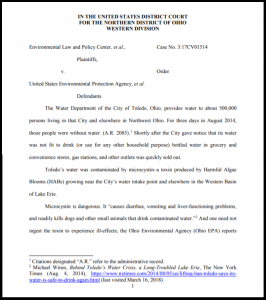
Activist: Agencies “not willing to act in the public interest”
A federal judge said last week that the U.S. Environmental Protection Agency had “given Ohio a pass” on declaring Lake Erie officially “impaired” for waters with toxic algae going back to 2012 and 2014.

District Judge James G. Carr, Photo by U.S. Department of Justice
The opinion written by Judge James Carr excoriated both the Ohio and the U.S. EPA’s for not living up to requirements under the Clean Water Act going back to 2012.
An “impaired” designation requires a state to implement a plan to remediate the deficiency. Ohio has consistently declined to designate the open waters of Lake Erie as “impaired” in spite of ample and long-standing scientific evidence to the contrary.
Ohio has instead, with the knowledge of its overseer, the U.S. EPA, parsed the law and played a game of “administrative pushball” according to Judge Carr where it tried to push responsibility for declaring the lake impaired back to the U.S. EPA based on an agreement with other states and Canada.
Michigan has declared its portion of Lake Erie impaired.
In the opening remarks of the decision, the judge set the table by recounting details of the 2014 Toledo water crisis where 500,000 people were told that their water was “not fit to drink or use for any other household purpose.”
The case before the judge was brought by Chicago’s Environmental Law and Policy Center (ELPC) and the Toledo nonprofit Advocates for a Clean Lake Erie (ACLE).
The groups sued saying that the U.S. EPA had missed deadlines in holding Ohio accountable for declaring whether or not the open waters of Lake Erie were “impaired.”
The judge’s ruling sent the case back to the U.S. EPA and gave the agency 30 days to either approve or disapprove of Ohio’s “impaired” waters list.
Perhaps sensing a legal defeat, Ohio has recently moved closer to declaring Lake Erie’s open waters impaired and has indicated a receptiveness to tighter regulations to control nutrient runoff from farms. Legislation with tighter regulations on farm activity is said to be in the works in the Ohio legislature.
The administration of Gov. John Kasich has consistently yielded to the requests of farmers who say voluntary measures to control pollution runoff will work.
Turning point
We think this decision is a “key pivot-point, a key turning point for cleaning up western Lake Erie and reducing the toxic algae that imperils safe drinking water,” the ELPC’s Executive Director Howard Learner told Great Lakes Now.
Learner said the judge’s decision is a “very strong opinion that has called out the Ohio EPA and the U.S. EPA for not doing their jobs very well.”
He noted that the judge said the agencies had engaged in procedural maneuvers that have a “whiff of bad faith to circumvent the basic requirements of the Clean Water Act.”

Lake Erie activist Mike Ferner, Photo by the Toledo Blade
The ACLE’s Mike Ferner told Great Lakes Now that at the recent hearing Judge Carr was “not at all happy with the Ohio and U.S. EPA.”
Ferner said he is pleased Carr is retaining jurisdiction over the case because he believes ongoing “federal legal oversight is necessary because the agencies haven’t shown that they are willing to act in the public interest.”
ACLE was founded in 2016 “to raise the noise level” on water quality issues in the Toledo area and to “name names” of people at the agencies who weren’t doing their jobs, according to Ferner.
Beyond the legal proceedings,the ELPC’s Learner told Great Lakes Now that in the Toledo area, “there is a consensus that it is no longer acceptable to have a blue-green algae scum in western Lake Erie contaminating and threatening local water supplies.”
Ferner echoed that sentiment and said that “it will take more than inside activists to clean up Lake Erie.” He said the public will have to be involved and it has started to embrace the issue.
Following a then record algae bloom in 2011 and the Toledo water crisis in 2014, it took traditional Great Lakes advocates like the Alliance for the Great Lakes, the National Wildlife Federation and the Ohio Environmental Council and others including the ELPC until late 2015 to call on the U.S. EPA to declare Lake Erie impaired.
Slow path to health
Judge Carr wrote in his decision that the U.S. EPA said that remediation of Lake Erie after an “impaired” designation could take between eight and 23 years.
Carr noted that in 1988 Ohio’s General Assembly moved to eliminate phosphorus from laundry detergent that also plagued Lake Erie in a law passed in 1990. .
The judge said similar legislative action to deal with nutrient runoff from farms “appears to be the most expeditious and effective means of accomplishing the goals of the Clean Water Act.”
“More importantly, it could probably do so in substantially less time than the potential twenty-three years it will otherwise take,” Judge Carr wrote.
Ohio Gov. Kasich’s term is up in 2019 leaving the governor’s seat open.

Howard Learner, President and Executive Director of the Environmental Law & Policy Center, courtesy of elpc.org
ELPC’s Learner has advice for citizens voting in this years gubernatorial race.
“People should be asking the candidates for governor, what action are you going to take to reduce pollution that has led to toxic blue-green algae blooms that threaten safe, clean drinking water for more than a half a million people in the Toledo area,” Learner says.
Neither the U.S. EPA or the Ohio EPA has commented on the judge’s ruling.
The National Oceanic and Atmospheric Administration begins its annual forecasts of Lake Erie algae blooms for 2018 in early May.





